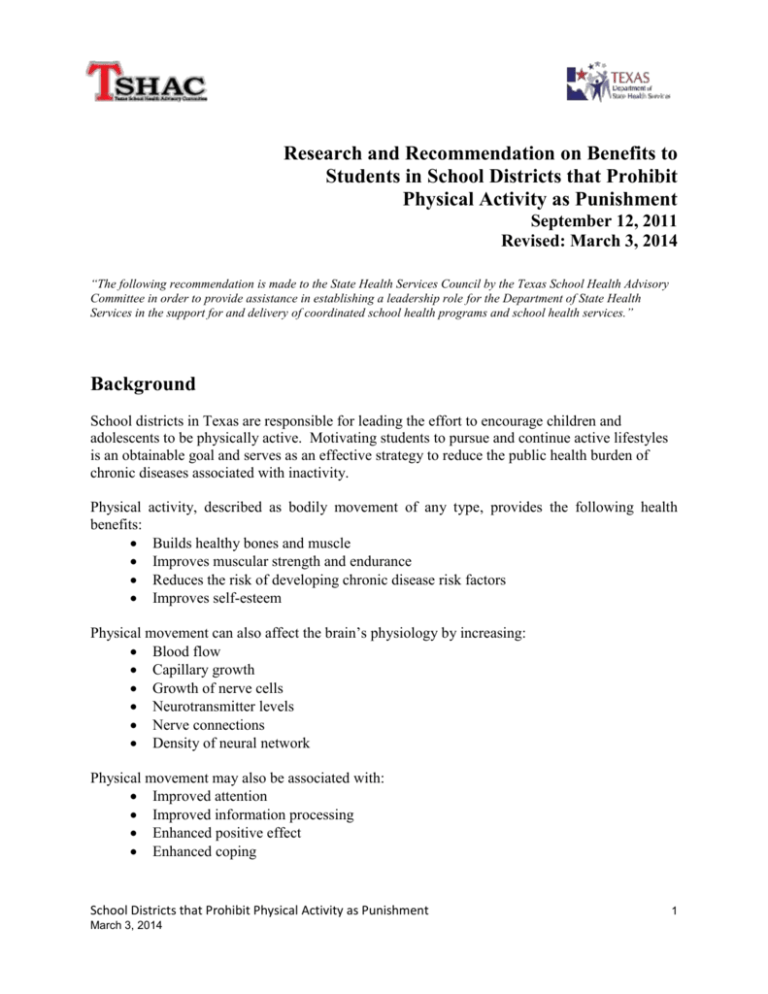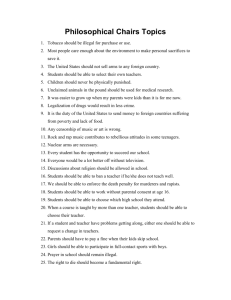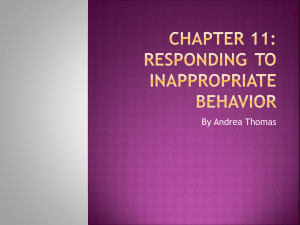Physical Activity as Punishment - Texas Department of State Health
advertisement

Research and Recommendation on Benefits to Students in School Districts that Prohibit Physical Activity as Punishment September 12, 2011 Revised: March 3, 2014 “The following recommendation is made to the State Health Services Council by the Texas School Health Advisory Committee in order to provide assistance in establishing a leadership role for the Department of State Health Services in the support for and delivery of coordinated school health programs and school health services.” Background School districts in Texas are responsible for leading the effort to encourage children and adolescents to be physically active. Motivating students to pursue and continue active lifestyles is an obtainable goal and serves as an effective strategy to reduce the public health burden of chronic diseases associated with inactivity. Physical benefits: activity, described as bodily movement of any type, provides the following health Builds healthy bones and muscle Improves muscular strength and endurance Reduces the risk of developing chronic disease risk factors Improves self-esteem Physical movement can also affect the brain’s physiology by increasing: Blood flow Capillary growth Growth of nerve cells Neurotransmitter levels Nerve connections Density of neural network Physical movement may also be associated with: Improved attention Improved information processing Enhanced positive effect Enhanced coping School Districts that Prohibit Physical Activity as Punishment March 3, 2014 1 A singular barrier that can be both physically and emotionally harmful to children and youth is the practice of using physical activity as punishment and/or behavior management. Examples of inappropriate use of physical activity include: Requiring students to run laps for misbehavior Forcing students to do push-ups for being late to class Withholding recess time to control behavior or to do unfinished work Making students run for losing a game or for poor individual performance Recommendation The purpose of this document is to assist local School Health Advisory Councils (SHACs) to revise or update Wellness Policies or other district policies/regulations to prohibit the use of physical activity as punishment. An example of a Wellness Policy related to physical activity in a school setting may include: Teachers and other school and community personnel will not use physical activity (e.g., running laps, pushups) or withhold opportunities for physical activity (e.g., recess, physical education) as punishment. When developing policies and regulations related to physical activity as punishment, some consideration needs to be given to the fact that at times it is necessary to temporarily remove a child from a competitive practice or game, unstructured recess or other activity in order to stop undesirable behavior immediately. Removing a student whose behavior threatens the safety of other students is an example of an appropriate action. In most instances, the removal should be very brief (one to six minutes), following a cool down period and counseling. For students receiving Special Education services, an individualized Behavior Intervention Plan should be followed, developed or revised as needed. The following is an example of a section of a recess policy related to the removal of students: Teachers should exhaust every reasonable alternative before considering redirecting recess for academic or disciplinary purposes. A teacher frequently redirecting recess shall meet with campus administration to evaluate the effectiveness of this choice for the students(s) involved. The Texas School Health Advisory Committee (TSHAC) recommends that every local SHAC review the position statements that follow of organizations associated with children and youth, as well as cited research to prohibit the use of physical activity as punishment in the schools. School Districts that Prohibit Physical Activity as Punishment March 3, 2014 2 Position Statements 1. National Association for Sport and Physical Education an association of the American Alliance for Health, Physical Education, Recreation and Dance. Administering or withholding physical activity as a form of punishment and/or behavior management is an inappropriate practice. NASPE opposes administering or withholding physical activity as a form of punishment and/or behavior management. School administrators, physical education teachers, classroom teachers, coaches, parents and others working with children and young adults play a critical role in providing meaningful physical activity experience. Therefore, teachers should see providing meaningful physical activity as a way to ensure that children and youth develop positive attitudes about physical activity and stop viewing physical activity as a punishment and/or behavior modification. 2. U. S. Department of Health and Human Services, Centers for Disease Control and Prevention “Guidelines for School and Community Programs to Promote Lifelong Physical Activity Among Young People.” Teachers, coaches, and other school and community personnel should not force participation in or withhold opportunities for physical activity as punishment. Using physical activity as a punishment risks creating negative associations with physical activity in the minds of young people. Withholding physical activity deprives students of health benefits important to their well-being. 3. Fit, Healthy and Ready to Learn National Association of State Boards of Education. The overall learning climate of the school needs to consistently promote physical activity as positive and desirable. Staff should never punish students for bad behavior by requiring physical activity, such as doing push-ups or running laps. 4. California Association for Health, Physical Education, Recreation and Dance. One of the prime goals of physical education programs is to provide students with positive experiences which will motivate them to pursue and develop active lifestyles. The practice of utilizing physical activity (running laps and doing calisthenics) as punishment develops student attitudes that are contrary to the stated objectives of CAHPERD. Teachers do not punish children with reading and then expect them to develop a joy for reading. Neither should teachers punish with exercise and expect children to develop a love of activity. School Districts that Prohibit Physical Activity as Punishment March 3, 2014 3 5. National Conference of State Legislatures School physical education programs offer the best opportunity to provide physical activity for all children and to teach them the skills and knowledge needed to establish and sustain an active lifestyle. Quality physical education offers learning opportunities, appropriate instruction, meaningful and challenging content. Recommended physical education program structure includes: Physical activity should never be used as punishment 6. Dakota County Public School, Minnesota Strategies for Schools – Avoid using Physical Activity as punishment Goal: Physical activity, such as running laps or doing pushups, should not be used by school or community personnel as punishment. Withholding opportunities for physical activity (e.g. recess, physical education) as punishment also sends a negative message about the role and purpose of physical activity. 7. CANFIT California Adolescent Nutrition and Fitness Program CANFIT believes that promoting physical activity to youth can be best achieved by: “Providing options, keeping it simple, teaching it often and doing it right!” Among CANFIT’s Golden Rules for Physical Activity includes: Create an Environment that Fosters Participation by All Offer a variety of activities Play games that involve all participants, not just a few Do NOT use physical activity as punishment or reward. This can cause youth to form negative associations with physical activity and be less inclined to participate. References (1) (2) (3) “Physical Activity Used as Punishment and/or Behavior Management,” Position Statement, 2009, National Association for Sport and Physical Education, an Association of the American Alliance of Health , Physical Education, Recreation and Dance, www.aahperd.org/naspe “Guidelines for School and Community Programs to Promote Lifelong Physical Activity Among Young People,” Centers for Disease Control, 1997, www.cdc.gov/mmwr/preview/mmwrhtml/00046823.thm “The Move: 2010-2011 National Implementation of the U.S. Physical Activity Plan, National Coalition for Promoting Physical Activity, www.ncppa.org School Districts that Prohibit Physical Activity as Punishment March 3, 2014 4 “The Association Between School-Based Physical Activity, Including Physical Education, and Academic Performance,” Centers for Disease Control and Prevention, July 2010, www.cdc.gov (5) “Physical Education and Physical Activity for Children,” National Conference of State Legislatures, 2010, www.ncsl.org (6) “Strategies for Schools – Avoid Using Physical Activity as Punishment,” Dakota County, Minnesota, 2006, www.dakotacounty.us (7) Let’s Move Initiative, Active Schools, 2011, www.letsmove.gov (8) Health, Mental Health and Safety Guidelines for Schools, Physical Education, www.nationalguidelines.org (9) The Physical Activity Matrix: Implementing the California after School Physical Activity Guidelines. CANFIT, March 2010, www.canfit.org (10) “Fit, Healthy and Ready to Learn” National Association of State Boards of Education, www.nasb.org (4) This document was developed by the TSHAC and presented to the DSHS State Health Services Council. For additional information about the committee, go to www.dshs.state.tx.us/schoolhealth/shadvise.shtm. External links to other sites appearing here are intended to be informational and do not represent an endorsement by the Texas Department of State Health Services (DSHS). These sites may also not be accessible to people with disabilities. External email links are provided to you as a courtesy. Please be advised that you are not emailing the DSHS and DSHS policies do not apply should you choose to correspond. For information about any of the initiatives listed, contact the sponsoring organization directly. For comments or questions about this publication, contact the School Health Program at 512-776-7279 or by email at schoolhealth@dshs.state.tx.us . Copyright free. Permission granted to forward or make copies in its entirety as needed. Texas Department of State Health Services School Health Program MC 1925 P. O. Box 149347 Austin, Texas 78714-9347 www.dshs.state.tx.us/schoolsite/default.shtm School Districts that Prohibit Physical Activity as Punishment March 3, 2014 5








